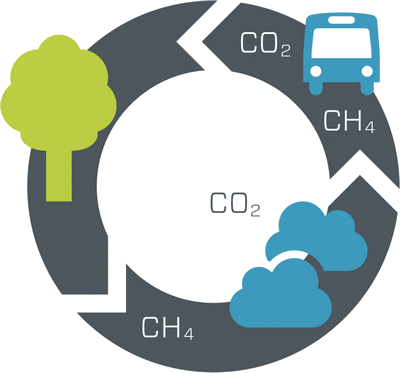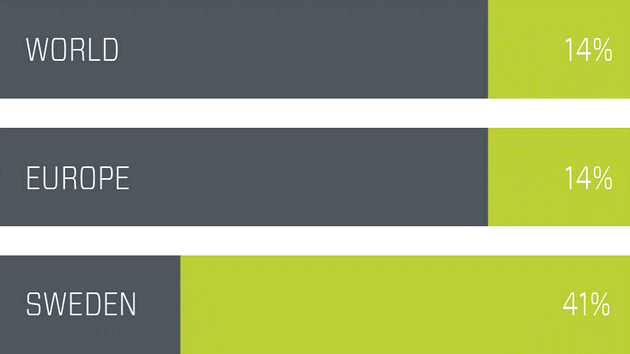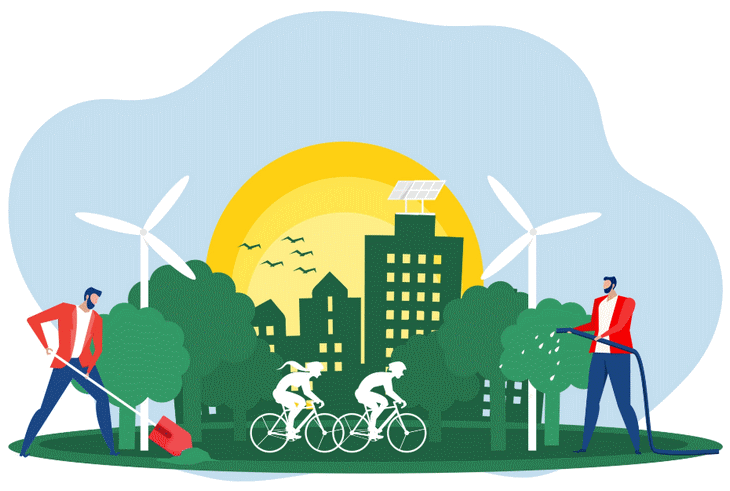Biogas: the cleanest fuel on the market
18 february 2023 – Biogas is the renewable alternative to fossil gas.
Industrial production is normally carried out in large digesters where an active bacterial flora breaks down the organic material, converting it into so called raw gas. In parallel, a digestate is generated, which in many cases can be used as a nutritive bio-fertilizer. Spread over arable land, it replenishes the earth with important nutrients such as nitrogen, phosphorus, potassium and magnesium.
Biogas production is a natural process, in which organic material is broken down by microorganisms in an oxygen-deficient environment

Between 0.5 and 1.0 cubic meter of biogas can typically be extracted from one kilo of dry organic material. However, the amount of biogas actually produced depends on the type of organic material used, the type of pretreatment and the digestion system as well as the know-how behind operating an efficient biogas production process. Using Scandinavian Biogas’ qualified expertise the biogas production can increase up to four times compared to conventional processes.
The main component of biogas is methane (CH4). Methane is a high-quality, energy-rich energy carrying gas generated by the anaerobic, decomposition of organic matter. During anaerobic digestion biogas is formed from fresh organic material and recycled in the biosphere, which means that no additional fossil carbon dioxide is being produced.
Renewable fuels are strategically important
Today, over thirty cities in Sweden power their municipal buses with biogas, which is also used by taxis and sanitation companies. Many industries also use renewable fuel, which like biogas, has become strategically important and at times even a prerequisite for doing business.
Light vehicles – Compressed biogas (CBG) for light vehicles is currently the main segment for biogas in Sweden, although this market is currently dependent on policy instruments. The market is also limited by the supply of gas cars and filling stations. In Sweden, filling stations are mainly concentrated in metropolitan areas, along the natural gas pipeline on the country’s west coast, and in Bergslagen. It is today possible to drive a gas vehicle throughout Göta- and Svealand and along the entire Norrland coast.
Buses – Public transport is a strong market for biogas and will remain a key driver in the industry. In 2017, approximately 20 per cent of Sweden's buses ran on biogas, a year-on-year increase of 10 per cent when calculated by number of vehicle kilometres. Municipalities often oversee treatment plants as well as public transport, which has provided opportunities for local cycles that utilise waste. Stockholm Public Transport (SL) and its operators are the players in Sweden that use the most biogas.
Heavy transport – An increasing number of heavy vehicles are powered by alternative fuels such as biogas. This also applies to long-haul traffic. Volvo, Scania, MAN, Mercedes and Iveco are some of the companies that have invested heavily in developing efficient, sustainable fuel solutions. The Euro 6 gas engine is essentially as effective as a diesel engine. Meanwhile, interest in gas trucks and lorries is on the rise in several European countries. Since freight transport is normally done across national borders, this affects conditions for biogas use also in Sweden and Norway. Renewable alternatives such as biogas also benefit from the expected rise in oil prices in the long term. Liquid biogas production and access to filling stations are factors that are currently limiting the use of biogas as a fuel for heavy transport.
 In Sweden, the share of renewable energy amounted to 41% t in 2017
In Sweden, the share of renewable energy amounted to 41% t in 2017
Shipping – The shipping sector has increased its use of gas as fuel in recent years. A 2017 review of newly ordered vessels with links to Sweden showed that half of all new vessels were built to run on gas. Although mainly liquid natural gas is being used, biogas can easily be blended with natural gas, or can replace it entirely. This trend has its origin in the sector’s environmental ambitions and tough new sulphur emissions standards for the Baltic Sea. Neither natural gas nor biogas give rise to sulphur emissions. Carbon dioxide emissions can be reduced by around 30 per cent using natural gas instead of heavy oil, and by a full 120 per cent using biogas. Supplying the shipping sector’s needs, however, requires large quantities of gas. As the supply of LBG increases, several shipping companies are ordering gas-powered vessels. And as more and more vessels are powered by gas, the need for biogas (LBG) also increases dramatically.
Industry – Approximately 9 TWh of gas is used annually by Swedish industry, with biogas representing only a small share of this amount. Most of the industries that use gas are located along the gas grid on Sweden’s west coast. In addition to reducing climate impact, the transition to gas from oil and other fossil fuels enables more precise process control. The food industry is therefore particularly interested in gas as a fuel. Estrella, for example, has been using biogas in its production of crisps and snacks since 2017, reducing its carbon emissions by 92 per cent. Stronger financial incentives and increased LBG production would enable biogas to achieve a real impact in industry.
Enormous growth potential in Europe
According to estimates, the market for methane-fuelled vehicles in Europe has enormous potential. European trade association NGVA expects the vehicle fleet to be 13 million strong by 2030, distributed between passenger cars, light vehicles, buses, heavy vehicles, and ships. This represents a ten-fold increase from current levels. The development potential for gas-fuelled lorries is deemed particularly significant – from the current 2,500 vehicles to 280,000 in 2030. The supply of renewable gas is expected to increase in parallel with this development. Reference(s).. NGVA, The Natural & bio Gas Vehicle Association (NGVA Europe)
Reference(s) and image for this article
scandinavianbiogas.com
